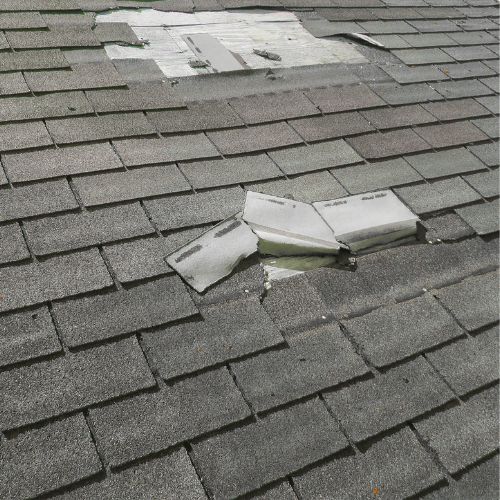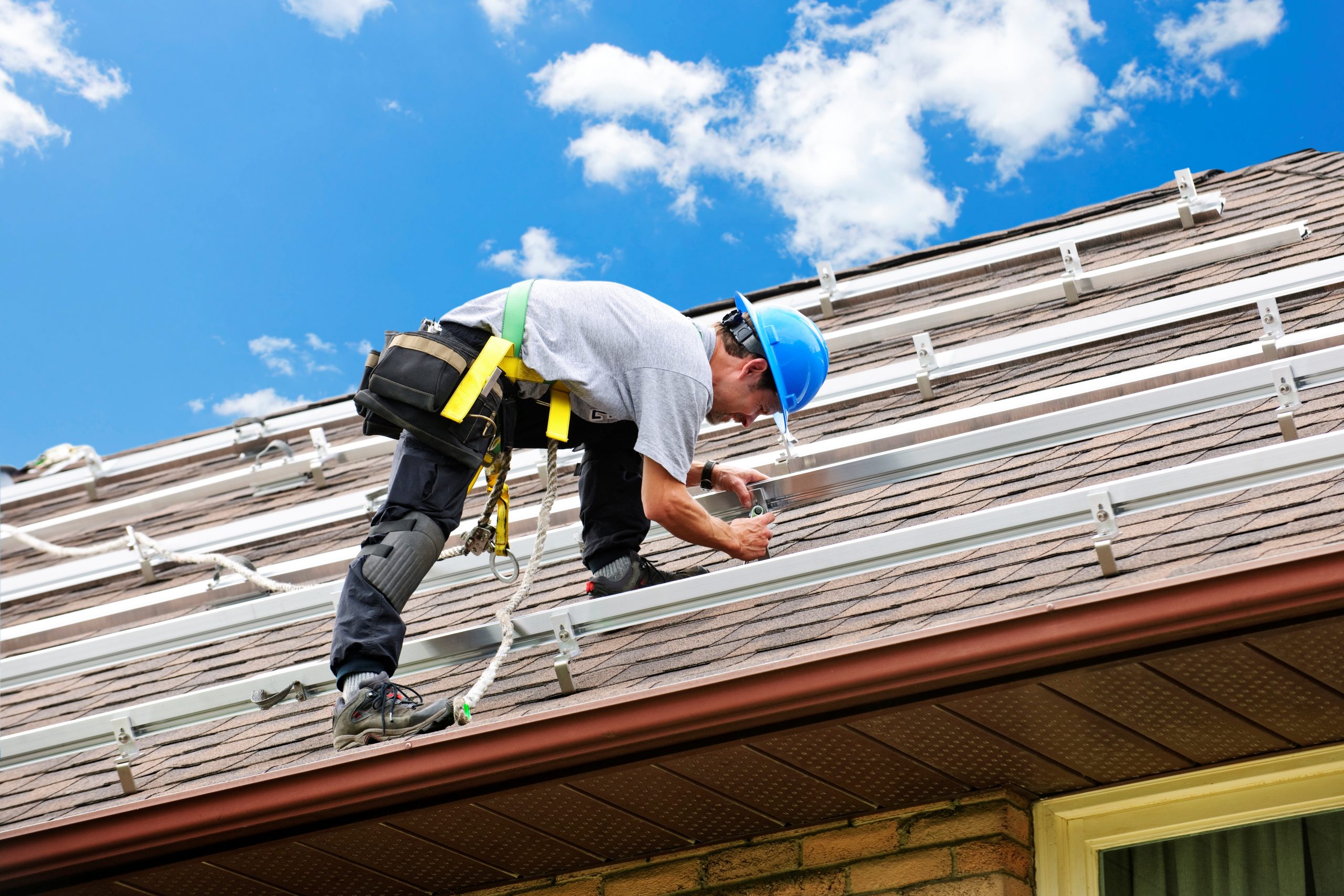Consistent Solutions by Skilled roofers st louis
Consistent Solutions by Skilled roofers st louis
Blog Article
Just How to Identify Typical Roof Covering Troubles and Their Solutions
When it comes to maintaining your roofing, identifying usual problems early can save you time and money. You could notice signs like water spots, missing roof shingles, or also moss development.
Indications of Roof Leaks and How to Repair Them
A leaking roof covering can transform your home into a headache if not attended to immediately. If you see peeling paint or mold growth, it's an indicator that wetness is caught.
To fix these problems, beginning by finding the source of the leak. Examine your attic for indications of dampness or water entry. For even more substantial damage, you might need to change tiles or even fix flashing.
Recognizing Missing or Damaged Tiles
When checking your roofing, search for any kind of missing or damaged roof shingles that might bring about larger troubles. An aesthetic assessment can disclose indicators of water damage, which may show that it's time to fix or change those tiles. Dealing with these concerns early can save you money and time in the long run.
Visual Assessment Strategies
To effectively identify missing or damaged shingles, start by carrying out a thorough visual assessment of your roof. Get a pair of binoculars for a closer look, or use a ladder if you're comfy. Look for any kind of tiles that are crinkled, fractured, or entirely missing. Pay special focus to locations around valleys, chimneys, and vents, as these areas are prone to damage. Try to find granules in your rain gutters or on the ground, which indicates wear. That might signify a trouble if you observe any type of discoloration or irregular surfaces. Don't neglect to inspect the edges of your roofing system; busted or loose tiles below can bring about bigger concerns. Routine assessments can help maintain your roof's stability.
Indications of Water Damages
While checking your roof for missing or harmed shingles, search for indicators of water damages that can show underlying problems. Look for dark streaks or spots on the shingles, as these typically signal dampness penetration. If you observe any curled or bent tiles, they might additionally be jeopardized, permitting water to seep through. Furthermore, evaluate the edges of your roof covering and around chimneys for any indications of rot or mold and mildew, which can mean long term moisture exposure. Don't fail to remember to examine your attic for water areas or damp insulation, as these can disclose leaks. Resolving these signs early can avoid much more substantial damage and expensive fixings down the line, ensuring your home remains secured.
Fixing or Replace Options

If you find missing out on or harmed shingles throughout your roof covering inspection, you'll need to determine whether to repair or replace them. The most effective option often depends on the level of the damages. If only a few tiles are affected and the remainder of your roof remains in great problem, a repair work may be all you require. Patch up those areas, and you can prolong your roof's life.
A new roof covering can improve your home's visual appeal and energy efficiency. Always think about the age of your roof and your spending plan when making this decision.
Identifying Sagging Roofings and Their Causes
Identifying a drooping roofing system is critical because it commonly indicates underlying structural issues that require prompt interest. Don't neglect them if you discover dips or unequal locations. Start by evaluating the roof covering for noticeable signs of sagging, like a bowing center or drooping eaves. These might show troubles with the rafters or trusses.

You need to additionally look for indicators of wood rot, which can damage the structure further. It's necessary to speak with a roof expert if you think sagging. Early treatment can protect against costly repairs and ensure the safety and security of your home. Don't wait; attending to the issue immediately can protect your investment and your comfort.
The Dangers of Moss and Algae Growth
Moss and algae development on your roof covering isn't simply an eye sore; it can present serious carcinogen and result in architectural damage over time. If left without treatment, these organisms can compromise your roof's integrity and create a breeding place for dangerous spores (roofing chesterfield mo). Let's discover exactly how to avoid and treat this issue successfully
Health Hazards of Development
While you could appreciate the natural charm of moss and algae on your roofing, it's crucial to recognize the potential carcinogen they pose. These developments can catch wetness, resulting in a wet atmosphere that advertises mold and mildew and mildew. Exposure to mold and mildew spores can trigger respiratory system concerns, allergic reactions, and other illness for you and your family. Additionally, if you have pets, they can additionally be influenced by the toxic substances released by specific kinds of algae. It is essential to maintain your roof covering clear of these growths to keep a healthy living environment. Regular upkeep and cleansing can help stop their accumulation, guaranteeing your home remains safe and your air top quality continues to be high. Do not neglect the significance of a tidy roof!
Structural Damages Dangers
If you allow moss and algae prosper on your roofing, you can be setting the stage for see this page severe architectural damage. These growths maintain moisture, which can permeate right into your roofing products, bring about decaying and degeneration. Gradually, this moisture can deteriorate your roofing system's structural stability, making it much more prone to leakages and other problems. roofing chesterfield his response mo. You could notice drooping locations or water stains inside your home, suggesting that the damages is already happening. Furthermore, moss and algae can raise tiles, creating gaps that permit further water invasion. Ignoring these indications not just risks your roof yet additionally the entire framework of your home. Addressing moss and algae promptly is necessary to maintaining your roofing system's life expectancy and guaranteeing your home remains risk-free.
Avoidance and Treatment Approaches
Overlooking moss and algae can bring about substantial problems, but taking safety nets and dealing with any kind of existing development can shield your roof covering. Beginning by regularly cleansing your roofing to eliminate debris and wetness, as this creates a setting for development. If you discover moss or algae, use a mixture of water and bleach to carefully scrub the affected locations. For avoidance, think about setting up zinc or copper strips along the ridge of your roofing; these metals hinder growth as rainfall washes over them. In addition, ensure your roof has correct air flow to decrease dampness accumulation. By remaining positive and dealing with these concerns immediately, you can expand your roofing's lifespan and preserve its honesty, saving you expensive repairs down the line.
Understanding Roofing System Air Flow Issues
Appropriate roof covering air flow is important for preserving the honesty of your home, as it helps control temperature and wetness levels in the attic room. Without ample air flow, you could encounter significant concerns sig roof tiles like mold and mildew growth, wood rot, and raised energy prices. Check your roof covering for signs of inadequate ventilation, such as too much warmth in the attic room throughout warm months or condensation creating on rafters.
You need to additionally seek uneven snow melting in winter season, indicating trapped warmth. It's time to assess your ventilation system if you notice any of these indicators. Ensure you have a well balanced intake and exhaust system, allowing fresh air in and stagnant air out.
You might need to include ridge vents, soffit vents, or gable vents to improve airflow. Regular upkeep and monitoring can protect against costly fixings down the line, so do not ignore this essential element of your roof system.

How to Spot Roofing System Flashing Problems
Maintaining excellent air flow is simply one component of a well-functioning roof; roof covering blinking plays a crucial role in keeping your home secure from water damage. To find flashing problems, start by inspecting the locations where various roofing sections meet, like chimneys, vents, and valleys. Search for any visible spaces, rust, or peeling off paint, which can suggest damage. Inspect for cracks in the caulk or sealer that might permit water to seep via.
Likewise, take a look at the blinking for any kind of signs of bending or misalignment; these problems can jeopardize its effectiveness. If you discover any of these indications, it's crucial to resolve them promptly to avoid expensive damage.
The Value of Routine Roof Assessments
While it's simple to ignore, normal roof covering examinations are vital for protecting the stability of your home. By arranging these assessments, you can capture prospective problems prior to they escalate into pricey repair work. Examiners will identify troubles like missing out on tiles, leakages, or put on around blinking that you could not see from the ground.
You'll also gain from tranquility of mind, understanding your roofing system remains in good form. Nevertheless, your roofing protects every little thing underneath it, from your family to your possessions. Normal evaluations can expand your roofing system's life-span and improve its efficiency, saving you cash over time.
Make it a habit to inspect your roof a minimum of two times a year and after considerable climate events. Staying aggressive regarding roof covering maintenance warranties you address minor concerns before they become major frustrations. Do not wait until it's as well late-- timetable your roof assessment today!
Frequently Asked Concerns
Exactly how Often Should I Schedule Specialist Roof Covering Evaluations?
You need to schedule expert roof covering examinations a minimum of yearly. After extreme weather events, it's wise to have an examination sooner. Routine checks assist catch prospective concerns prior to they rise right into pricey repair work.
Can I Repair My Roofing system Myself, or Should I Employ a Service Provider?
You can try roof covering repairs yourself if you're confident and have the right tools, but hiring a specialist ensures professional quality and safety. Consider your abilities and the job's complexity prior to choosing.
What Are the Indicators I Required a New Roofing?
You'll understand you need a brand-new roofing when you find significant leakages, missing roof shingles, comprehensive granule loss, or sagging locations. If your roofing's age exceeds two decades, it's time to ponder replacement options.
How Much Does Roof Covering Repair Service Normally Cost?
Roof repair service prices typically range from $300 to $1,500, depending upon the damages and materials required. You'll intend to obtain multiple quotes to ensure you're making the most effective decision for your spending plan.
What Materials Are Best for Roof Covering in My Climate?
You must think about products like asphalt shingles for moderate climates, steel for longevity, and clay ceramic tiles in warm regions. roofing chesterfield mo. Each choice has one-of-a-kind benefits, so think of your climate's particular needs and your home's design
When checking your roof covering, look for any missing or harmed tiles that could lead to bigger problems.To effectively determine missing out on or harmed shingles, start by carrying out an extensive aesthetic inspection of your roofing.While inspecting your roofing for missing out on or harmed tiles, look for signs of water damage that can indicate underlying problems.If you uncover missing or damaged shingles during your roofing evaluation, you'll need to decide whether to repair or replace them.Maintaining good ventilation is just one part of a well-functioning roofing system; roofing system flashing plays a crucial function in maintaining your home secure from water damages.
Report this page